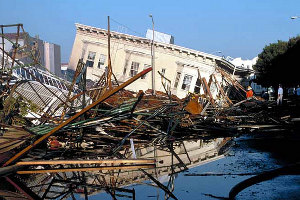[jwplayer config=”QUEST Audio Player” skin=”http://ww2.kqed.org/quest/wp-content/themes/quest/glow.zip” file=”http://www.kqed.org/.stream/anon/radio/quest/2011/04/2011-04-11-quest.mp3″ ]
Listen to the QUEST radio story Earthquake Warning
The Sendai area, which was hardest hit, received about ten seconds. In Tokyo, farther from the epicenter, residents had 30 to 60 seconds before the worst of the shaking took place.
Here in California, we have no such system, which means if an earthquake were to hit here residents would have no warning at all.
“This has been sort of percolating along in the seismological community for a long, long time,” says Douglas Given, a geophysicist with the United States Geological Survey. “But it’s only since about 2007 that we started working on it seriously here in the US.”
The groundwork for a system is already in place. It’s a network of about 400 seismic monitoring sites, scattered across California.
One of them is near UC Berkeley, in a vault dug into the side of a hill. The vault was built during the cold war, to try and detect the vibrations of other countries’ nuclear tests. Today it houses instruments so sensitive that they can pick up shaking on the other side of the planet.
A couple years ago, I got a tour from Richard Allen, the assistant director of UC Berkeley’s Seismological Laboratory. (You can see photos of the vault in the slide show, below.)
“The way the early warning system works,” explained Allen, “is it makes use of the fact that the energy that radiates during an earthquake, there’s two types of energy.”
The first are called P waves. They travel fast but are relatively weak. Then come S waves, which are sluggish but do a lot more damage. Once you know how fast the S waves are traveling, you can calculate when they’ll reach other parts of the state, and quickly send out a warning before the S waves arrive.
But here in California, that might not be a lot of time.
“Unfortunately,” says Allen, “our faults go right beneath the metropolitan regions. If you’re right above the quake, even with an early warning system, you probably won’t get any warning.”
But the farther away the epicenter, the more warning you get. Allen says if we’d had an early-warning system back in 1989, during the Loma Prieta quake, Oakland residents could have had 15 seconds of warning.
That’s enough time to close the toll plaza on the Bay Bridge, or to open up fire station doors, so they don’t jam shut during the earthquake. David Oppenheimer, a seismologist with the USGS in Menlo Park, says there’s a lot you can do with just few seconds.
“You really need to think about automatic applications,” he says, “elevators stopping at the next floor, doors opening, alarms in schools saying duck and cover with a voice telling you what to do.”
And of, course, consider major surgery.
“One example that I always like to give because people cringe is what if someone’s performing cataract surgery on you, and obviously you’d like the surgeon to remove the scalpel away from your face.”
In Japan, the alarm system automatically triggered a slow down of the country’s bullet trains. That’s probably why none of them derailed.
John McPartland who represents BART District 5, made the case last week at a meeting in Berkeley of earthquake early warning advocates.
“If we don’t have this warning system,” he said, “and we’ve got trains that are traveling at 60-70 miles per hour, and we end up derailing 20 to 30 trains, that’s going to end up [causing] one heck of a doggone toll in injuries and misery.”
So far, arguments like these have fallen on deaf ears in Congress.
Each year, the program gets about 500 thousand dollars, barely enough to continue basic research. Now, that line item has been cut entirely from the President’s latest budget proposal.
Unless Congress reinstates the funding, the early warning program will stay where it is, says Given, “held together with duct tape and bailing wire. It’s not a reliable system, or a complete system.”
Getting the system up to speed would cost $80 million, over five years. Given and others who work on the program say it’s been a tough sell.
Japan, after all, didn’t start building its warning system until after the devastating Kobe quake in 1995. Same thing in Mexico, says Given. “After the 1985 Mexico City earthquake, there was suddenly — for some strange reason, maybe 8K fatalities? — a public will to move forward with the system.”
It would be wise, he says, not to repeat that pattern here in the States.
“It’s our hope that we can get sufficient interest and build a system without first having to have a killer earthquake.”
According to the USGS, the chance of a magnitude 6.7 or larger earthquake shaking California over the next 30 years is greater than 99 percent.
37.457396 -122.169681
 Loma Prieta earthquake, Marina Diistrict of San Francisco, 1989. Courtesy of California Watch.
Loma Prieta earthquake, Marina Diistrict of San Francisco, 1989. Courtesy of California Watch. 